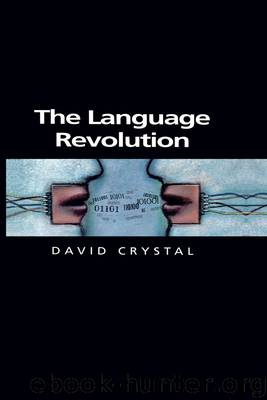The Language Revolution by Crystal David

Author:Crystal, David
Language: eng
Format: epub
Publisher: Wiley
Not like writing
If Netspeak does not display the properties we would expect of speech, does it instead display the properties we expect of writing? Here too, there are fundamental differences. Let us consider first the space-bound character of traditional writing – the fact that a piece of text is static and permanent on the page. If something is written down, repeated reference to it will be an encounter with an unchanged text. We would be amazed if, upon returning to a particular page, it had altered its graphic character in some way. Putting it like this, we can see immediately that computer-mediated communication is not by any means like conventional writing. A ‘page’ on the Web often varies from encounter to encounter (and all have the option of varying, even if page-owners choose not to take it) for several possible reasons: its factual content might have been updated, its advertising sponsor might have changed, or its graphic designer might have added new features. Nor is the writing that you see necessarily static, given the technical options available which allow text to move around the screen, disappear/reappear, change colour, and so on. And from a user point of view, there are opportunities to ‘interfere’ with the text in all kinds of ways that are not possible in traditional writing. A page, once downloaded to the user’s screen, may have its text cut, added to, revised, annotated, even totally restructured, in ways that make the result seem to come from the same source as the original. The possibilities are causing not a little anxiety among those concerned about issues of ownership, copyright and forgery.
The other Internet situations also display differences from traditional writing, with respect to their space-bound presence. E-mails are in principle static and permanent, but routine textual deletion is expected procedure (it is a prominent option in the management system), and it is possible to alter messages electronically with an ease and undetectability which is not possible when people try to alter a traditionally written text. What is especially revolutionary about e-mails is the way the medium permits what is called framing. We receive a message from M which contains, say, three different points in a single paragraph. We can, if we want, reply to each of these points by taking the paragraph, splitting it up into three parts, and then responding to each part separately, so that the message we send back to M then looks a bit like a play dialogue. Then, M can do the same thing to our responses, and when we get the message back, we see M’s replies to what we sent. We can then send the lot on to someone else for further comments, and when it comes back, there are now three voices framed on the screen. And so it can go on – replies within replies within replies – and all unified within the same screen typography. There has never been anything like this in the history of human written communication.
Download
This site does not store any files on its server. We only index and link to content provided by other sites. Please contact the content providers to delete copyright contents if any and email us, we'll remove relevant links or contents immediately.
Cecilia; Or, Memoirs of an Heiress — Volume 1 by Fanny Burney(32503)
Cecilia; Or, Memoirs of an Heiress — Volume 2 by Fanny Burney(31913)
Cecilia; Or, Memoirs of an Heiress — Volume 3 by Fanny Burney(31900)
The Lost Art of Listening by Michael P. Nichols(7456)
Asking the Right Questions: A Guide to Critical Thinking by M. Neil Browne & Stuart M. Keeley(5712)
We Need to Talk by Celeste Headlee(5578)
On Writing A Memoir of the Craft by Stephen King(4893)
Dialogue by Robert McKee(4357)
Pre-Suasion: A Revolutionary Way to Influence and Persuade by Robert Cialdini(4188)
I Have Something to Say: Mastering the Art of Public Speaking in an Age of Disconnection by John Bowe(3861)
Elements of Style 2017 by Richard De A'Morelli(3325)
The Book of Human Emotions by Tiffany Watt Smith(3271)
Fluent Forever: How to Learn Any Language Fast and Never Forget It by Gabriel Wyner(3058)
Name Book, The: Over 10,000 Names--Their Meanings, Origins, and Spiritual Significance by Astoria Dorothy(2961)
Good Humor, Bad Taste: A Sociology of the Joke by Kuipers Giselinde(2924)
Why I Write by George Orwell(2917)
The Art Of Deception by Kevin Mitnick(2770)
The Grammaring Guide to English Grammar with Exercises by Péter Simon(2726)
Ancient Worlds by Michael Scott(2653)
